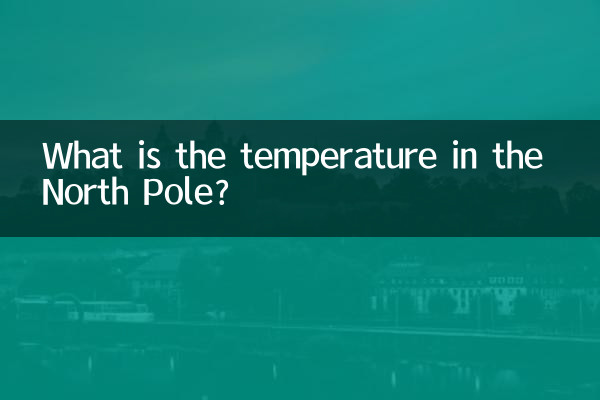What is the temperature in the North Pole?
Recently, temperature changes in the Arctic have become the focus of global attention. As climate change intensifies, temperature fluctuations in the Arctic are having profound effects on ecosystems and weather patterns around the world. This article will combine hot topics and hot content in the past 10 days to provide you with a detailed analysis of the current temperature conditions in the Arctic and the scientific reasons behind them.
1. Recent Arctic temperature data

According to meteorological monitoring data, the temperature in the Arctic has fluctuated significantly in the past 10 days. The following are temperature records for the past 10 days in parts of the Arctic:
| Date | area | Maximum temperature (℃) | Minimum temperature (℃) | Average temperature (℃) |
|---|---|---|---|---|
| 2023-11-01 | northern greenland | -5 | -12 | -8.5 |
| 2023-11-03 | northern siberia | -8 | -15 | -11.5 |
| 2023-11-05 | Within the Arctic Circle (Svalbard, Norway) | -3 | -10 | -6.5 |
| 2023-11-07 | northern canada | -7 | -14 | -10.5 |
| 2023-11-09 | northern alaska | -4 | -11 | -7.5 |
2. Causes of Arctic temperature anomalies
Temperature changes in the Arctic are closely related to global climate change. The following are some of the major causes of abnormal temperatures in the Arctic:
1.greenhouse gas emissions: Greenhouse gases such as carbon dioxide produced by human activities cause global warming, and the Arctic region is particularly affected by this.
2.Reduced sea ice: Melting of Arctic sea ice allows more solar radiation to be absorbed by the ocean, further exacerbating temperature rises.
3.Polar vortex weakens: The weakening of the polar vortex is causing cold air to spread southward while temperatures rise in the Arctic.
4.Impact of warm ocean currents: The northward movement of the North Atlantic Current brings more heat to the Arctic.
3. Impact of Arctic Temperature Changes
Abnormal changes in Arctic temperatures have had a profound impact on global ecosystems and human life:
1.sea level rise: Melting glaciers and reduced sea ice are causing global sea levels to rise, threatening coastal cities.
2.More extreme weather: Arctic temperature changes have affected global atmospheric circulation, leading to frequent extreme weather events.
3.ecosystem destruction: The living environment of polar bears, seals and other polar creatures is seriously threatened.
4.Resource development disputes: Resource development in the Arctic has become an international focus due to rising temperatures, triggering geopolitical controversy.
4. Forecast of future trends
Scientists predict that the temperature in the Arctic will continue to rise in the future. The following is the predicted data on Arctic temperature changes in the next 10 years:
| Year | Predicted average temperature (℃) | Comparison with 20th century average (°C) |
|---|---|---|
| 2025 | -6.0 | +3.2 |
| 2030 | -5.2 | +4.0 |
| 2035 | -4.5 | +4.7 |
5. Global response measures
Faced with the challenge of rising Arctic temperatures, the international community is taking the following measures:
1.Reduce carbon emissions: Countries have committed to reducing greenhouse gas emissions through international agreements such as the Paris Agreement.
2.scientific research cooperation: Many countries jointly carry out Arctic scientific expeditions to strengthen monitoring of climate change.
3.ecological protection: Establish Arctic nature reserves to limit the damage to polar ecology caused by human activities.
4.public education: Raise public awareness of Arctic conservation through media and education campaigns.
Temperature changes in the Arctic are not only a scientific issue, but also a major challenge related to the future of mankind. Only global joint efforts can slow down the trend of Arctic warming and protect our common home.

check the details

check the details